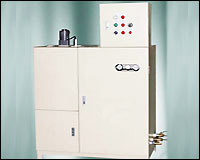| Home > Production Process > Mold Release Agents |
Mold Release Agents |
 A mold release agent is a chemical/substance used to get a slip effect so that the finished products can be efficiently removed from the molds without effecting the perfection of the molded surface. Good mold release agents maximize the process efficiency by reducing cycle time and eliminate the need for a bake cycle. Ideally these agents should be such that they do not alter the finish of the molded products and also not interfere with auxiliary processing requirements. Another important requirement of MRA is that they should prevent the pigments from streaking, accumulating, or swirling due to the static electricity that develops as a result of the rotational molding cycle. Textured surfaces and tight tolerances necessitate extra demands on the performance of these release agents
A mold release agent is a chemical/substance used to get a slip effect so that the finished products can be efficiently removed from the molds without effecting the perfection of the molded surface. Good mold release agents maximize the process efficiency by reducing cycle time and eliminate the need for a bake cycle. Ideally these agents should be such that they do not alter the finish of the molded products and also not interfere with auxiliary processing requirements. Another important requirement of MRA is that they should prevent the pigments from streaking, accumulating, or swirling due to the static electricity that develops as a result of the rotational molding cycle. Textured surfaces and tight tolerances necessitate extra demands on the performance of these release agents
Types of Mold Release Agents:
There are a wide variety of mold release types available commercially. Most of these can be categorized into two three main types :
- Sacrificial coatings
- Semi-permanent coatings
- Permanent coatings
 Sacrificial Coatings:
Sacrificial Coatings:
These coatings has to be applied every time a new molded part is being manufactured as most of the mold release agent material comes off as the mold is released from the tool. A typical sacrificial coating MRA is Silicone.
Semi-Permanent Coatings:
This is the most used type of MRA in rotomolding. Normally, these coatings last for quite a number of releases provided they are applied correctly. These coatings are generally made up of a synthetic chemical called polysiloxane.
Permanent Coatings:
These are certain type of Teflon coatings that has to be applied only once. These type of MRA coatings are very susceptible to damage when misused.
|
| |
| |
 |
